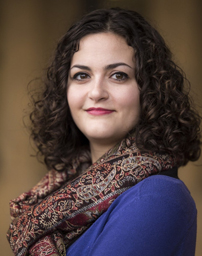Junior Faculty Spotlight: Adeana McNicholl
The CFT highlights the work of our Junior Faculty Teaching Fellows. In this post, Adeana McNicholl, Religious Studies, talks about some of the lessons she has gained from the Fellowship.
 I am an Assistant Professor of Buddhist Traditions in the Religious Studies department. My research focuses on Buddhism in ancient South Asia and Buddhism in the United States. In my scholarship and teaching, I aim to identify and decenter colonial frameworks of knowledge about religion. In the religious studies classroom, I encourage my students to hone their skills in critical analysis of religion in the public sphere. My students learn that arguments about religion are never neutral and that defining religion does real work in the world. We consider who has the power to define religion, what is at stake when those definitions are made, and how narratives about religion are bound up in histories of colonialism and imperialism, policing, surveillance, and exclusion.
I am an Assistant Professor of Buddhist Traditions in the Religious Studies department. My research focuses on Buddhism in ancient South Asia and Buddhism in the United States. In my scholarship and teaching, I aim to identify and decenter colonial frameworks of knowledge about religion. In the religious studies classroom, I encourage my students to hone their skills in critical analysis of religion in the public sphere. My students learn that arguments about religion are never neutral and that defining religion does real work in the world. We consider who has the power to define religion, what is at stake when those definitions are made, and how narratives about religion are bound up in histories of colonialism and imperialism, policing, surveillance, and exclusion.
Through the JFTF program, I designed a new course offering for Spring 2022, “Asian and Asian-American Religions in the U.S.” A central thesis for this course is that Asian and Asian American religious history is American religious history. That is to say,we cannot tell the story of religion in the United States without discussing Asians and Asian Americans. Throughout the course, students will identify the major historical milestones for the development of Asian and Asian-American religions in the United States and consider how Asian and Asian-American religions, and our knowledge of these traditions, are shaped by systems of power.
The seminar discussions helped me refine my own thinking about this course. Particularly useful were the discussions on backwards design. This allowed me to consider how to scaffold the course to reflect the skills I want students to develop and the enduring understandings I would like them to take away from the classroom.To support this, I reorganized the course from a chronological arrangement to a series of religions based on a specific religion: Buddhism, South Asian religions, Islam, and Christianity.By organizing this way, students will be better able to meet our learning goals of interrogating the content of the term “religion,” each religion’s relationship with race, and the way that religion and race impact national belonging. To help students make connections between different religions at specific historical moments we will create a collaborative public timeline of Asian/Asian-American religious history throughout the semester. Through projects like this, students can think of themselves as not only consumers of knowledge about religion, but also producers of that knowledge.
Through my teaching consults, I strategized about how to adapt the lessons learned from COVID-19 to continue to implement technology and hybrid teaching models in the classroom. Some of my favourite class assignments have been “unessay” projects (a term I borrow from Profs. Ryan Cordell and Emily Suzanne Clark), in which students are given the option to use alternative formats to present their research. Many of these projects have incorporated digital media. Students have presented their argument and evidence in the form of public-facing narratives through video, podcasts, and websites. I believe that when used appropriately, technology can help make our classrooms more accessible and engaging for our students.
.
.
.
.
.
.

Leave a Response